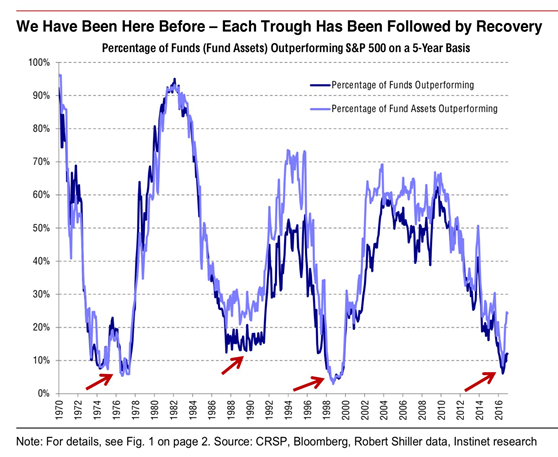Active management used to be easier. Information took forever to percolate out. Big buyers and sellers accidentally tipped their hands, giving more nimble traders opportunities. Good analysts at small banks didn’t move stocks, but even mediocre analysts at big banks did. And short-term correlations were lower than medium-term correlations: if every pharma stock but JNJ opened higher one morning, it was better than even money that JNJ would catch up by noon.
None of this is true any more:
- Stocks react to information more or less instantly: natural language processing allows quantitatively-inclined traders to write a program to quickly digest the contents of a press release and decide whether it’s good news or not.
- Big orders get broken up into small orders. A fairly simple calculation like VWAP can allow a large investor to slice their trades so finely they’re indistinguishable from normal market noise.
- Off-the-shelf and in-house solutions help hedge funds and mutual funds determine how much credence to put in a given analyst’s upgrades and downgrades. And retail investors make up a smaller proportion of the market than they used to, so there isn’t a constituency that’s indiscriminately loyal to one company’s analysts.
- Correlations between asset prices have gone up, and statistical arbitrage ensures that they stay at a pretty high level. Now, if there’s a single stock lagging behind the rest of their industry, algorithms spot it when it’s behind by a penny per share, not by half a percent.
What all of these sources of mispricings have in common is that they’re inefficiencies in how other people handle short-term information, and in how they structure trades. These inefficiencies all gave rise to the term “dumb money” — the people you’d try to identify and bet against.
People don’t use the term “dumb money” much any more, because the dumb money is mostly gone. Increasingly, it’s been replaced by passive investors who buy index funds, and by automated traders who offer liquidity and try to stay out of the way of big trades. Call them the Zen Money: instead of losing a lot because they traded too aggressively, they’ve resigned themselves to losing a little by not trading aggressively at all.
Socially, this is a good thing: investors get better returns, with less risk. But for active managers, the Zen Money strategy removes a source of easy profits. So it’s reasonable for active investors to worry: what if the easy money was the only money?
But then there’s this highly motivational chart a hedge fund friend sent me a few weeks ago:

We’ve seen this movie before. The markets get more efficient over time, most of the time. But inefficiencies build up, and it’s at times when stock pickers are most frustrated that correlations start to break down agani and opportunities start to re-emerge.
Where Alpha Is Going
Passive investment management — buying a representative sample of stocks and bonds, then waiting — relies on an efficient market. Bluntly, you’re always paying for active management: either you’re paying someone else to pick stocks for you, or you’re paying because somebody doesn’t.
And an efficient market in turn relies on people taking the time to evaluate investments. As the easy and quantifiable sources of alpha disappear, what’s left is anything that’s hard to feed into a model or hard to measure against historical returns. That includes:
- Changes in industry dynamics: For most of the last thirty years, Warren Buffett derided airlines as a terrible investment. They can’t effectively negotiate against unions, and they don’t have any pricing power. But now that airlines are consolidating, that’s changed and he’s long airlines in size. You could have seen this coming — albeit a decade too early — by looking at how online travel agencies’ models changed. When they got off the ground, all the money was in airline tickets themselves; now, when Expedia sells you an airline ticket, it’s a loss-leader to get you to book a hotel.
- Spinoffs: Spinoffs are basically a way to trade small amounts of excess complexity over a long time period for lots of complexity upfront: instead of having a business that’s always a minor pain to analyze, you have a prospectus that’s a huge headache to read, after which there are two easily-understood businesses. There are many businesses that naturally transition into two related businesses with different economic characteristics, whether that’s a hotel operating company and a real estate company that owns hotels, or an online travel agent and a web community focused on travel. Spinoffs are hard for passive investors to handle; in some cases, the company spun off doesn’t fit whatever criteria the passive manager uses to select stocks, so they’re forced to sell. John Malone is singlehandedly responsible for a big chunk of spinoff-related alpha, both because of his management acumen and his propensity to lump together assets and then split them off again. (Malone has also made a fortune from his ability to defer taxes indefinitely. I won’t say he hates the IRS. It just so happens that whenever the IRS shows up at the party, Malone is leaving through the back door.)
- Private companies: Hedge funds, especially technology funds, are increasingly investing in early-stage private companies. These companies are much less efficiently priced, in part because they’re illiquid and in part because they’re uncertain. What you tend to see in private markets is that sellers are more informed, but they’re also much more motivated to sell: if you had a four-digit checking account and an eight-digit equity position in a single stock, how hard would you quibble over the last 5%?
- Inefficient efficiencies: One way the market has changed in the last 20 years is that it used to be that when a misleading headline hit, you’d have to wait a few minutes for the stock to move as poorly-informed day-traders bought or sold aggressively. Thanks to Moore’s Law and savvy programming, a headline-reading algo trader can instantly overreact to a bogus headline. In the aggregate, automation has made it hard to trade headlines. But in a few cases — obvious to humans, too subtle for bots — automation has made it very, very easy.
- Meta inefficiencies: Spurious correlations in markets abound. And if there’s a correlation, someone out there will chase it. This creates a feedback loop: if IBM tends to coincidentally rise on rainy Tuesday afternoons, automated traders trade on this signal. And when they do, IBM will rise on Tuesday afternoons as soon as the first cloud appears in the sky. Active investors don’t have to know why stocks move to know that automated trading adds some noise to markets, and that betting against noise is a winning strategy. History repeats, details don’t. In quant terms, we’re always overfitting to the past.
A purely efficient market is actually a glaring inefficiency: too many people poring over spreadsheets, not enough people building companies. It’s bound to unwind. And when it does, the stock pickers will be waiting.

